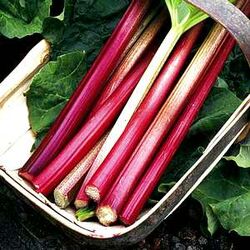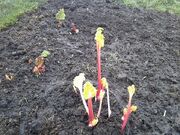| Rhubarb | |
|---|---|
 |
|
| Scientific Classification | |
| Kingdom: | Plantae |
| (Unranked): | Angiosperms |
| (Unranked): | Eudicots |
| Order: | Caryophyllales |
| Family: | Polygonaceae |
| Genus: | Rheum |
| Species: | Rheum rhabarbarum |
| Plant Data | |
|---|---|
| Germination time: | 90 days |
| Time to harvesting: | +365 days |
| Ideal pH range: | 6.0 - 6.8 |
| Growing plant spacing: | 90cm (36in) |
| Growing row spacing: | 90cm (36in) |
Although the leaves of rhubarb are toxic, various parts of the plants have medicinal uses. Fresh raw stalks are crisp (similar to celery) with a strong tart taste most people find unpleasant when raw. Most commonly the plant's stalks are cooked and used in pies and other foods for their tart flavour. The varieties grown for consumption have been domesticated, most of which are recognised as Rheum x hybridum by the Royal Horticultural Society.
Planner[]
| JAN | FEB | MAR | APR | MAY | JUN | JUL | AUG | SEP | OCT | NOV | DEC | |||||||||||||
|---|---|---|---|---|---|---|---|---|---|---|---|---|---|---|---|---|---|---|---|---|---|---|---|---|
| Planting Time | ||||||||||||||||||||||||
| Pulling Time | ||||||||||||||||||||||||
Growing[]
Location[]
Rhubarb is not a fussy plant and will survive in most sites provided the soil is not subject to long periods of waterlogging in winter.
Soil[]
Dig the site deeply in autumn and incorporate plenty of compost or rotted manure. Rake in a general fertilizer shortly before planting.
Planting[]
Plant rhubarb crowns 90cm (36in) apart in all directions. The crown should be placed into a hole slightly deeper than it, covered over and firmed in place.
After care[]
Keep the growing plants well watered and remove any flowering shoots as soon as they appear. Feed them with a liquid fertilizer during the summer. If this is not done, sprinkle a general fertilizer around the crowns once the harvesting season is over. In January or February mulch the crown with compost or well-rotted manure.
Harvesting[]
Sticks are ready to begin pulling in April. Hold the stalk firmly close to the base, pull up and twist. Always ensure you leave at least 4 stalks. Stop harvesting at the end of July. New plants should not be harvested for the first 12-18 months while they become established.

Yellow leaves on a forced rhubarb (Note the circle in the soil where the bucket has been)
Forcing[]
Plants can be 'forced' for a February-March crop: cover the crown with an up-turned bucket and cover with compost or straw. The sticks of this plant will grow prematurely and can be harvested in 6 weeks. You should not force a rhubarb more than once every 3 years.
Preserving[]
Rhubarb freezes excellently. Just remove the leaves and cut the stalks into bite-sized peices for freezing(this saves defrosting the stalks before using them in cooking).
Troubles[]
Varieties[]
- Champagne early
- Timperley early
- Glaskin's perpetual
- Victoria
| This page uses Creative Commons Licensed content from Wikipedia (view authors). |